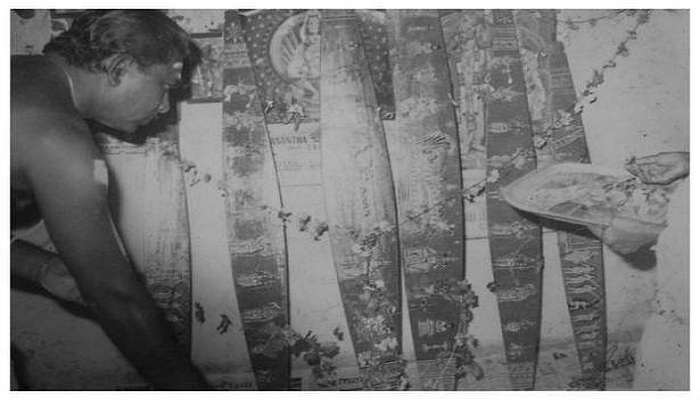
The tradition of consecrating the Onavillu in Sree Padmanabhaswamy temple, according to the traditional craftsmen, has a colourful legend behind it, linking it to Mahabali, the legendary Asura king, and the Onam festival. Legend has it that when Vamana, the dwarf incarnation of Lord Vishnu, was about to push Mahabali down into the depths of patala (the subterranean realms of the universe), the king implored Vishnu for a vision of all his divine incarnations. Vishnu granted him the boon but Mahabali would see his incarnations only in a painted form.
Lord Viswakarma, the supremo of arts and crafts and the legendary ancestor of all the craftsmen, was tasked with painting all the 10 incarnations of Vishnu on a ceremonial bow. This bow was put up every year during Onam when Mahabali returned from patala to meet his subjects.
The work on the Onavillu commences with a special pooja by the craftsmen who observe strict vrata (fasting) for 41 days. Wood from kadambu, mahogany, jackfruit, aanjili and maruthu trees, abundantly available in Kerala, are used to fashion the bows. The bow-shaped wooden panels are made in three sizes and the flat face of the wooden bow is made smooth to paint the figures of the Gods.
Types of Onavillu

Ananthasayanam, Dasavatharam and Sree Krishna Leela were the three bows that were traditionally consecrated in the temple. In 1994, a new bow depicting Sree Rama Pattabhishekam was also dedicated in the shrine of Lord Rama and the tradition continues till date. Further, in 2010, two new bows for Lord Sastha and Lord Ganesha were added to the lot.
“The main idol in Sree Padmanabhaswamy temple shows the Lord reclining on the coils of Anantha, the divine serpent, with his eyes half closed in Yoganidra or the yogic trance. In contrast, on the Onavillu, Sree Padmanabhaswamy is portrayed in Veerashayana, with his eyes open and face turned towards the onlooker,” says Binkumar, the head of the Vaniyanmoola Vilayil family associated with the making of the Onavillu.
The red kunchalam (tassels) tied on both sides of the bow is made by convicts housed in the Poojappura Central Jail, a tradition that dates back to the late nineteenth century.

Post Your Comments